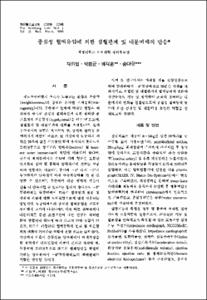중심성 혈액유입에 의한 심혈관계 및 내분비계의 반응
- Alternative Author(s)
- Chae, E Up; Bae, Jae Hoon; Song, Dae Kyu; Park, Won Kyun
- Journal Title
- Keimyung Medical Journal
- Issued Date
- 1993
- Abstract
- This study was attempted to clarify the regulatory mechanism on the systemic and pulmonary vascular reponses through the low pressure receptor, the ventricular performance, and the hormonal changes to the central blood shift at-6˚head-down tilt.
In 39 anesthetized dogs(8-14kg), 21dogs (tilt group) were tilted from the supine position to the -6˚head-down position(HDP) for 30 minutes, then back to the supine recovery position for the next 30 minutes. The rest 18 dogs were kept in the supine position without tilt as the control group for the same time course of the tilt group. Cardiac output(Q), heart rate(HR), stroke volume(SV),
thoracic fluid volume(TFV),index of ventricular contractility(IC)and ventricular acceleration index(ACI)were determined by the impedance cardiograph(BoMed co). Systemic arterial pressure(SAP) and pulmonary arterial pressure(PAP) were measured at the brachial and pulmonary arteries respectively, and central venous pressure(CVP) also at the right atrium. And the systemic and pulmonary vascular resistances(SVR and PVR) were calculated by dividing SAP and PAP with Q respectively. The concentration of plasma atrial natriuretic peptide(ANP) and antidiuretic hormone (ADH), and plasma renin activity(PRA) in the arterial blood were measured by the radioimmunoassay in 8 dogs in each group at 5 minutes before, and 25 and 55 minutes after beginning of the tilt.
At the HDP, TFV increased rapidly and maintained the elevated level during the HDP, where as it decreased gradually in the control group. Q showed the tendency to increase and SAP, PAP and HR did not change significant differences in the changes of HR, PAP and CVP between the tilt and the control group.
SVR and PVR reduced in the tilt group, where as they elevated gradually in the control group. There were significant differences in the changes of SVR and PVR between the tilt and the control group at the early stage of HDP.
SV, IC and ACI increased at the early stage of HDP in the tilt group, where as they decreased gradually in the control group.
Plasma ANP,ADH and PRA did not change significantly in the both groups.
In conclusion, the cardiopulmonary baroreceptors induced the vasodilations on both systemic and pulmonary vessels by the central blood shift and the ventricular systolic performance was enhanced at the early stage of the head-down tilt. But the concentration of the plasma ANP and ADH, and PRA did not show significant changes in this study.
- Alternative Title
- Cardiovascular and Hormonal Response to Central Blood Shift
- Publisher
- Keimyung University School of Medicine
- Citation
- 채의업 et al. (1993). 중심성 혈액유입에 의한 심혈관계 및 내분비계의 반응. Keimyung Medical Journal, 12(1), 13–24.
- Type
- Article
Items in Repository are protected by copyright, with all rights reserved, unless otherwise indicated.
